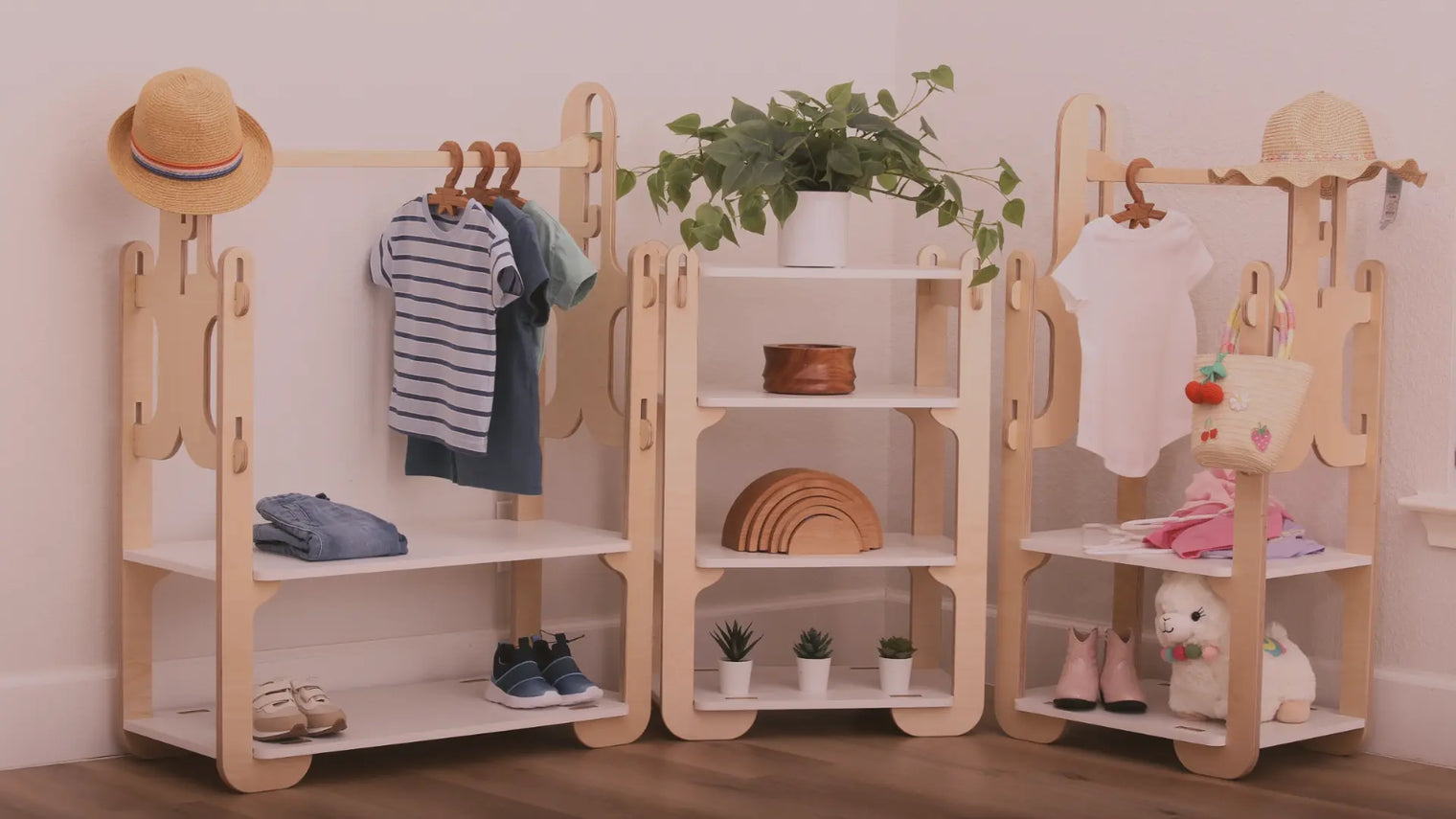Create a Montessori wooden wardrobe that fosters independence with functional design, organization tips, and essentials for all kids.
A Montessori wooden wardrobe is more than just a space to store your child’s clothes; it’s a tool to nurture independence and self-reliance, key principles of the Montessori method. By creating a wooden wardrobe that is both functional and accessible, children are empowered to dress themselves, make choices, and take responsibility for their belongings. In this post, we’ll guide you through the essential items and organization techniques to create the perfect Montessori wooden wardrobe, designed for toddlers, young children, and older kids.
What Makes a Montessori Wooden Wardrobe Different?
Traditional wardrobes are often designed with adults in mind. They're tall, feature drawers or shelves that are difficult for children to reach, and don’t allow much autonomy for kids. A Montessori wooden wardrobe, on the other hand, is built with children at the center. It’s simple, accessible, and designed to encourage independence from an early age. Clothing and accessories are placed at a child-friendly height, making it easy for them to access their clothes, learn organization skills, and develop a sense of responsibility over time.
For an example of child-accessible storage, check out our Montessori clothing rack, which allows children to select their outfits independently.
Must-Have Items for a Montessori Wooden Wardrobe
When setting up a Montessori wooden wardrobe, there are several essential items that can make the space more functional and user-friendly for children. Here are some of the most important items you should consider:
1. Montessori Clothing Rack
A Montessori clothing rack is the centerpiece of any Montessori wardrobe. Unlike traditional wardrobes with high bars, a Montessori rack is low-standing, making it easy for children to reach their clothing. This setup empowers children to select their outfits each day, helping them develop decision-making skills and a sense of control over their routines.
We recommend the Montessori 20- Inch Clothing Rack for toddlers and younger children. It’s compact, simple, and built at the perfect height for little ones to grab their own clothes. For older children who need more space for hanging items, the Montessori 20-Inch Clothing Rack provides more room without compromising accessibility.
You can read more about how clothing racks like these foster independence in children in our detailed blog post.
2. Baskets and Bins for Small Items
Baskets and bins are essential for organizing smaller clothing items like socks, underwear, and accessories. By placing baskets on low shelves or within drawers, you allow children to easily sort and select these items on their own. This encourages them to take responsibility for their belongings and keep their space organized.
Opt for natural woven baskets or wooden bins to stay in line with the Montessori philosophy, which favors simple, natural materials. These can also be placed underneath the clothing rack for easy access. Using open-top baskets allows children to quickly see and grab what they need, preventing frustration during their morning routine.
3. Low-Standing Wooden Dresser
While a Montessori clothing rack is great for hanging outfits, a low-standing Montessori dresser is perfect for folded clothes like shirts, pajamas, or pants. Choose a dresser with wide, easy-to-open drawers that children can access without adult help. Keep clothing minimal and organized by category in each drawer to prevent clutter.
A Montessori dresser is especially helpful for older children who need to store more clothing items or prefer folding their clothes. Look for dressers made from durable wood, as this aligns with the Montessori approach of using natural materials that are long-lasting and sustainable. A wooden baby clothes rack paired with a Montessori dresser creates a cohesive and functional wardrobe that meets all of your child’s needs.
4. Hooks and Pegs for Accessories
Hooks and pegs are fantastic additions to a Montessori wooden wardrobe. They allow children to hang accessories such as hats, bags, or scarves at their own height. These small but helpful organizational tools help children keep their space neat and ensure that accessories aren’t lost or misplaced.
By positioning hooks and pegs within your child’s reach, you further support their ability to care for their belongings. You can also use pegs to display seasonal clothing items like jackets or coats, allowing your child to prepare for the weather by themselves.
5. Rotating Seasonal Clothes
A key Montessori principle is simplicity, and this applies to your child’s wardrobe as well. Too many options can overwhelm children, making it harder for them to make decisions. One great way to keep things simple is by rotating seasonal clothes. Keep only the clothes they need for the current season accessible in the wardrobe, and store the rest elsewhere.
This keeps the wooden wardrobe uncluttered and makes it easier for children to see their options. It also teaches children the concept of seasonal changes and how their clothing choices should adapt accordingly. A Montessori wardrobe isn’t just about accessibility—it’s about teaching life skills like organization and planning.
Creating an Organized Montessori Wooden Wardrobe for Different Age Groups
While the core items in a Montessori wooden wardrobe remain similar across different age ranges, you can adjust the setup to match your child’s developmental stage.
For Toddlers
For toddlers, keep the wardrobe as simple as possible. Focus on easy-to-wear items such as elastic waistbands and Velcro shoes. Use a compact Montessori clothing rack paired with a few open baskets to store socks, hats, and other small accessories.
For Children (3-6 Years)
As your child grows, introduce more complex clothing options such as shirts with buttons or zippered jackets. Add a Montessori dresser with labeled drawers for different clothing categories like shirts, pants, and pajamas. Encourage your child to help fold and organize their clothes.
For Older Children (6+ Years)
For older children, you can introduce more organizational tools like hooks for accessories and baskets for shoes. Give them more responsibility by involving them in seasonal clothing rotations and encouraging them to categorize their clothing in ways that make sense to them. A larger clothing rack can also be added to store a wider range of clothing options.
Conclusion
A well-organized Montessori wooden wardrobe is the foundation for teaching children valuable life skills like independence, responsibility, and organization. With essentials like low-standing clothing racks, wooden dressers, baskets, and hooks, you can create a functional, child-centered space that promotes autonomy and reduces stress in daily routines.
If you’re ready to create the perfect Montessori wardrobe for your child, explore our range of clothing racks and other Montessori-inspired furniture designed to foster independence at every age.

